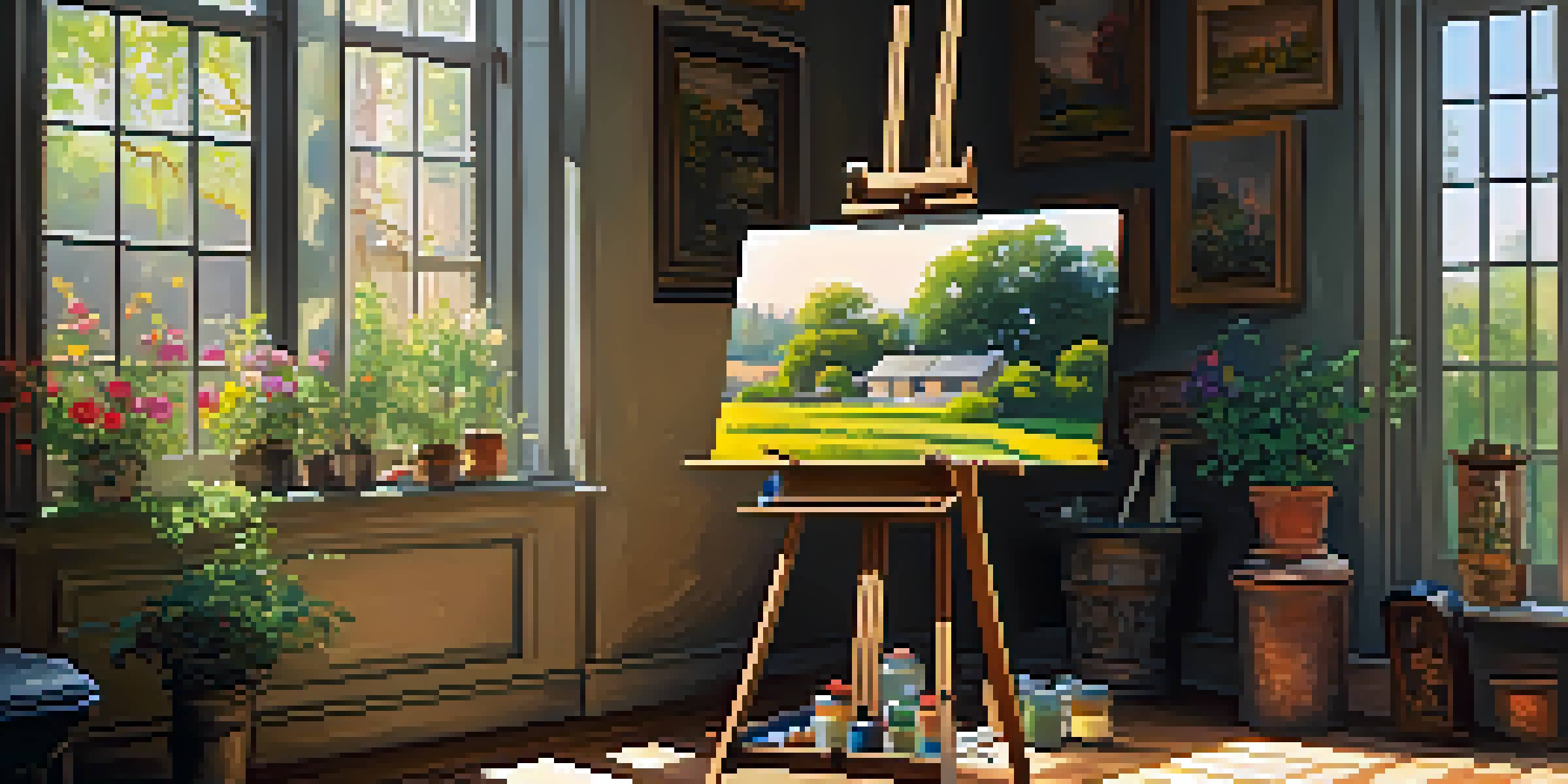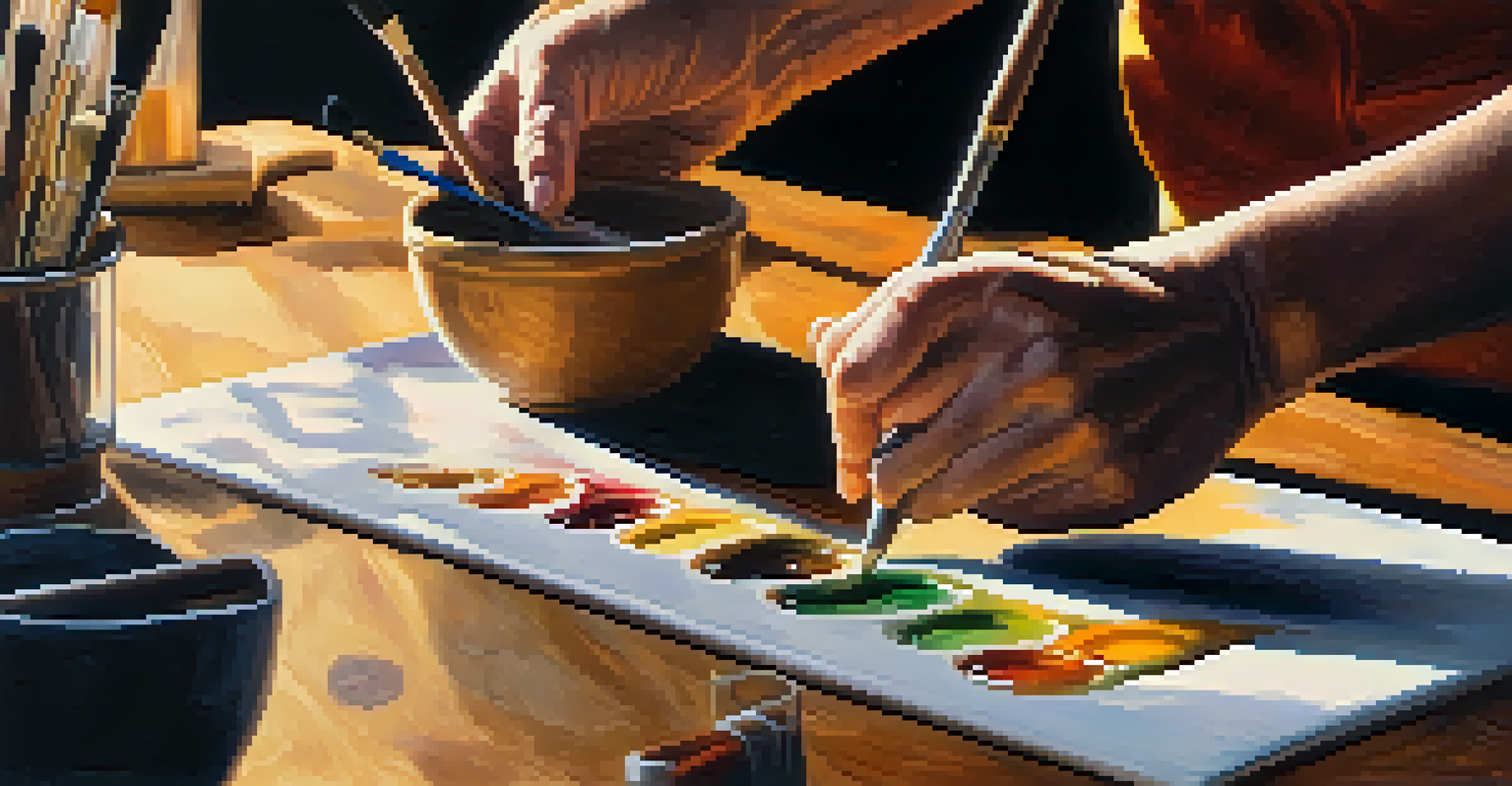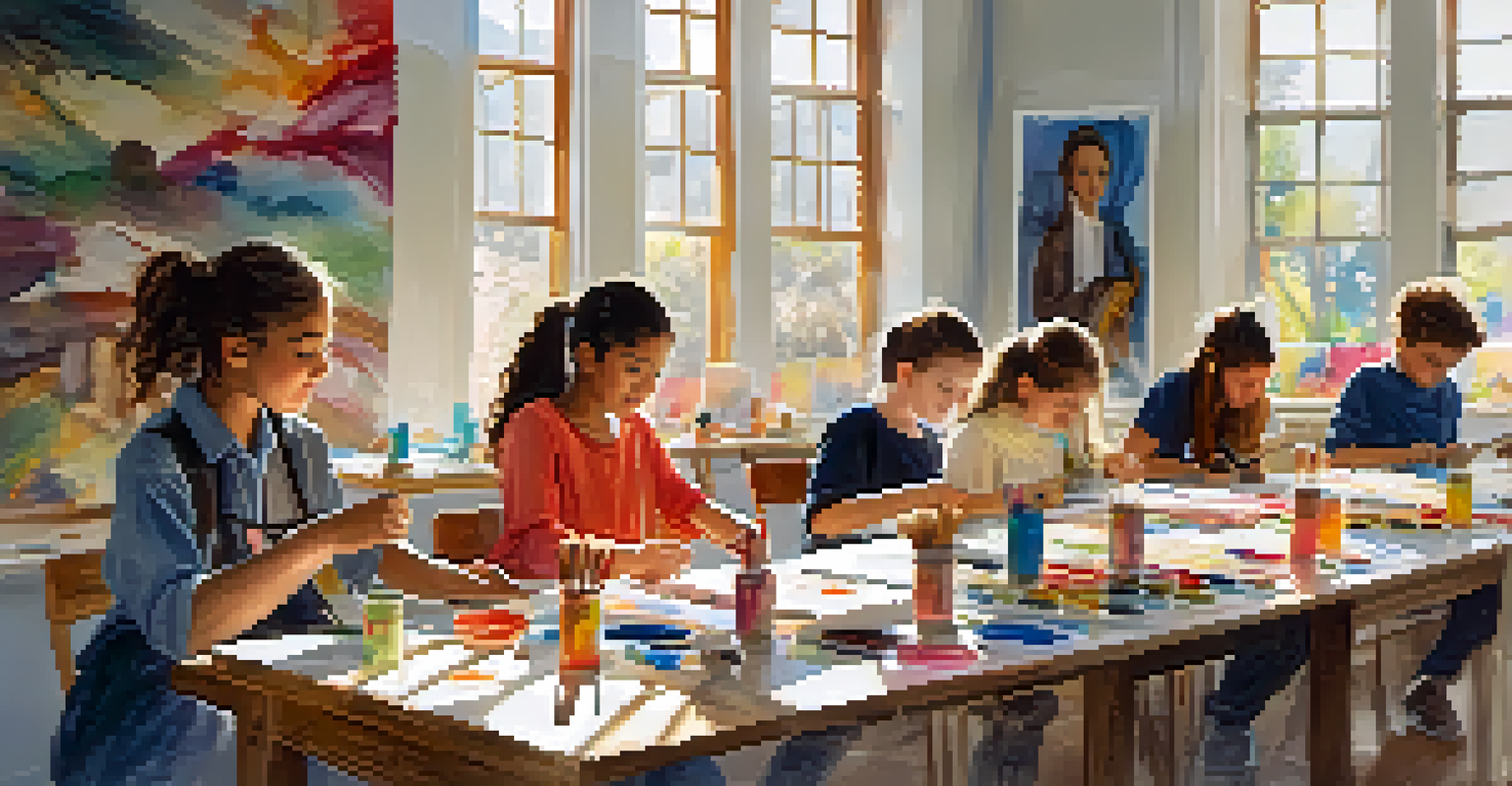The Resurgence of Traditional Techniques in Modern Painting

Understanding Traditional Techniques in Art
Traditional painting techniques encompass methods that have been used for centuries, such as oil painting, watercolor, and fresco. Each technique has its own unique qualities, allowing artists to express themselves in diverse ways. For example, oil painting is renowned for its rich colors and textures, while watercolor offers a delicate transparency that can create ethereal effects.
Art is not what you see, but what you make others see.
These methods were once the standard in art education, forming the foundation for many modern practices. However, with the rise of digital art and contemporary styles, these traditional techniques began to fade into the background. Yet, the resurgence of interest in these age-old methods has sparked a renaissance among both seasoned artists and newcomers alike.
This revival can be attributed to a growing appreciation for craftsmanship and authenticity in art. Artists are rediscovering the joy of working with their hands and the tangible results that traditional techniques provide. This not only enhances their artistic skills but also connects them with a rich history of artistic expression.
The Influence of Digital Art on Traditional Techniques
While digital art has revolutionized the creative landscape, it has also prompted a reassessment of traditional techniques. Many artists now blend digital methods with traditional practices, creating a hybrid style that showcases the strengths of both mediums. This fusion allows for innovative approaches while still honoring the craftsmanship of traditional painting.

For instance, an artist might create a digital sketch before refining it with oil paints on canvas. This approach not only streamlines the creative process but also cultivates a deeper understanding of color, composition, and texture. As a result, artists are able to push the boundaries of their work, resulting in fresh and exciting pieces that resonate with a modern audience.
Revival of Traditional Techniques
There is a renewed interest in age-old painting techniques, as artists seek authenticity and craftsmanship.
Moreover, this integration of digital and traditional art has opened new avenues for learning and collaboration. Whether through online tutorials or social media platforms, artists can share techniques and inspire one another, fostering a community that values both modern innovation and traditional skill.
Reviving Forgotten Techniques in Modern Art
Amid the resurgence of traditional techniques, many artists are also exploring forgotten methods that have been sidelined over time. Techniques such as egg tempera or casein painting are now being reintroduced into contemporary art practices. By reviving these methods, artists are able to create unique textures and effects that set their work apart.
Every artist dips his brush in his own soul, and paints his own nature into his pictures.
For example, egg tempera, which uses egg yolk as a binder, produces vibrant colors that dry quickly and can be layered for depth. This technique has seen a revival among artists who appreciate its historical significance and the challenge it presents. They find joy in mastering something that not only pays homage to the past but also offers fresh creative possibilities.
This exploration of forgotten techniques encourages a deeper connection between the artist and their craft. It invites a sense of experimentation that can lead to unexpected outcomes, ultimately enriching the artistic process. As artists share their journeys of rediscovery, they inspire others to delve into the past, fostering a culture of learning and innovation.
The Role of Art Education in Traditional Techniques
Art education plays a crucial role in preserving and promoting traditional painting techniques. Many art schools are reintroducing these methods into their curricula, ensuring that students gain a well-rounded foundation in art. By learning traditional techniques, students develop essential skills that can enhance their creative endeavors in any medium.
This return to traditional methods in education fosters an appreciation for the history of art and the craftsmanship involved. Students learn the significance behind each technique, which can deepen their understanding and appreciation of contemporary works. This connection to the past often inspires students to innovate while respecting the roots of their craft.
Digital Art Blends with Tradition
Many artists are merging digital methods with traditional practices, creating innovative hybrid styles.
Additionally, workshops and community classes focusing on traditional techniques are becoming increasingly popular. These hands-on experiences allow individuals of all skill levels to explore and practice these methods, creating a vibrant community of learners and artists. As more people engage with traditional painting techniques, they contribute to a culture of artistry that values both heritage and innovation.
The Impact of Social Media on Traditional Art
Social media has transformed how artists share their work and connect with audiences, providing a platform for traditional techniques to reach a wider audience. Artists can showcase their processes through time-lapse videos or step-by-step tutorials, demystifying traditional methods for viewers. This visibility helps to reignite interest in these techniques among aspiring artists and art enthusiasts alike.
Platforms like Instagram and TikTok allow artists to present their work in creative ways, sparking conversations about the value of traditional practices in a digital world. Viewers can engage with artists directly, asking questions and sharing their own experiences. This interaction fosters a sense of community, making traditional art more accessible and relatable.
Moreover, social media encourages the celebration of diverse artistic expressions. Artists from various backgrounds share their unique interpretations of traditional techniques, enriching the art narrative. This diversity not only broadens the appeal of traditional methods but also inspires new generations to explore and innovate within this framework.
The Market for Traditional Art Techniques
As interest in traditional techniques grows, so does the market for artworks that embody these methods. Collectors and art enthusiasts are increasingly drawn to pieces that showcase skillful craftsmanship and a connection to history. This trend encourages artists to invest time in mastering these techniques, knowing that their work will be appreciated and valued.
Galleries and exhibitions dedicated to traditional art have also become more prevalent, providing artists with opportunities to showcase their work in a supportive environment. These venues highlight the beauty and complexity of traditional techniques, attracting audiences who may not have previously engaged with this style of art. This growing appreciation can lead to increased sales and visibility for artists.
Art Education's Vital Role
Art education is reintroducing traditional techniques, ensuring students appreciate their historical significance.
Furthermore, online platforms have made it easier for artists to sell their traditional works globally. Artists can reach a wider audience, connecting with collectors who seek authenticity and craftsmanship. This accessibility not only benefits individual artists but also contributes to a broader cultural appreciation for traditional art techniques.
Celebrating the Future of Traditional Techniques
The resurgence of traditional techniques in modern painting invites a celebration of creativity and craftsmanship. As artists embrace these methods, they weave together the past and present, creating a rich tapestry of artistic expression. This revival not only honors the history of art but also encourages innovation and experimentation.
Looking ahead, it’s clear that traditional techniques will continue to evolve and adapt within the contemporary art scene. Artists are finding new ways to incorporate these methods into their unique styles, ensuring that the spirit of traditional painting remains alive. This ongoing dialogue between tradition and modernity keeps art vibrant and relevant.

Ultimately, the future of traditional techniques is bright, as more artists and audiences recognize their value. By celebrating these methods, we not only preserve a rich artistic heritage but also inspire future generations to explore the depths of creativity. As we appreciate the beauty of traditional painting, we pave the way for a dynamic and diverse art world.